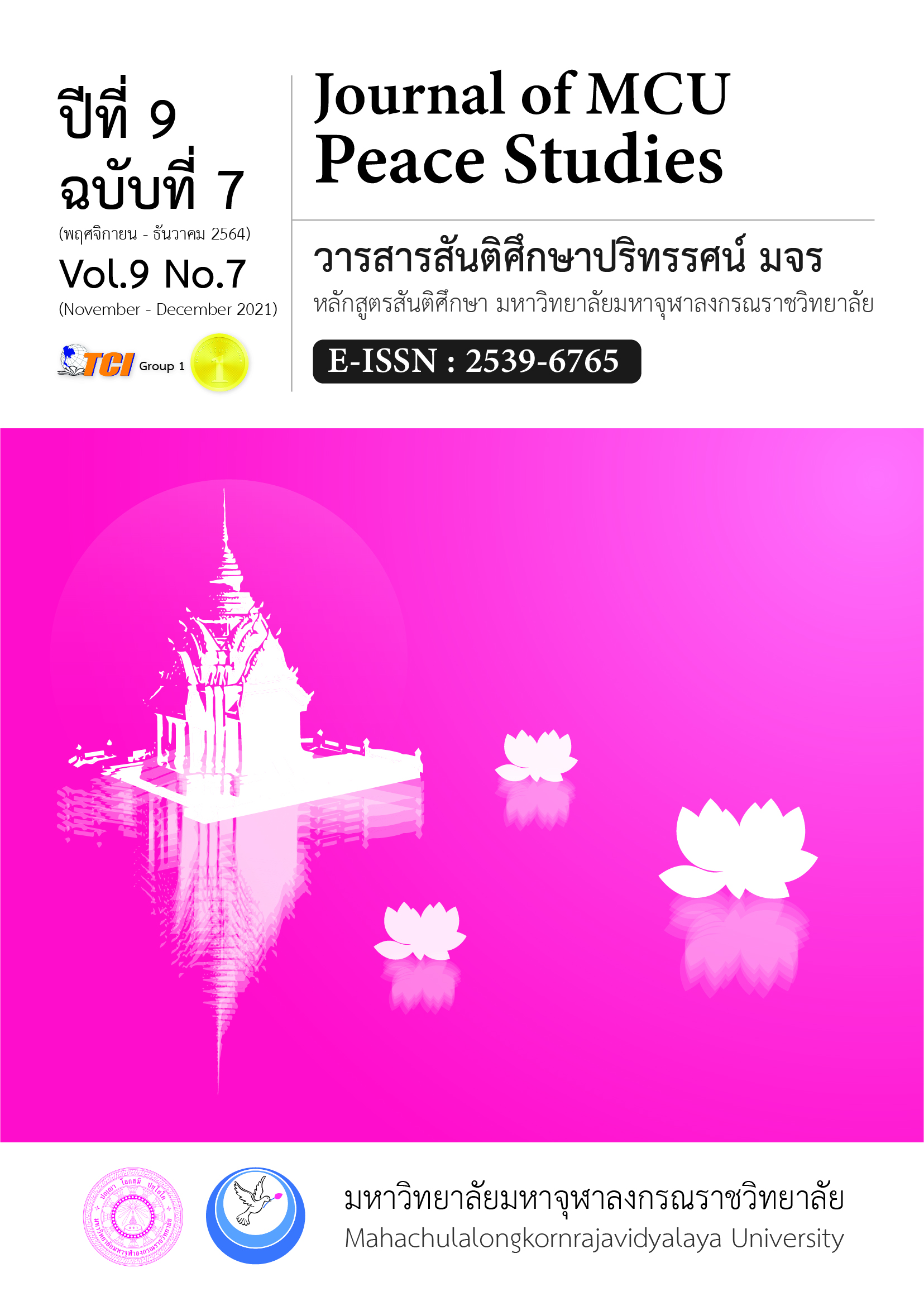การศึกษาการเมืองเรื่องกลุ่มทหารในประเทศไทยตั้งแต่ พ.ศ. 2516-2562
Main Article Content
บทคัดย่อ
บทความวิจัยนี้ มีวัตถุประสงค์เพื่อ 1) ศึกษาการก่อตัวของกลุ่มทหารโดยเฉพาะการก่อตัวของกลุ่มทหารภายในกองทัพบกไทย และ 2) การเข้ามามีบทบาททางการเมืองของกลุ่มทหารตั้งแต่ พ.ศ. 2516-2562 วิธีการศึกษาเป็นการศึกษาวิจัยเชิงคุณภาพ โดยศึกษาจากการวิเคราะห์เอกสาร บทความ หนังสือ งานวิจัย หนังสือพิมพ์ และสิ่งพิมพ์ต่าง ๆ โดยนำข้อมูลที่ได้มารวบรวมวิเคราะห์ แล้วทำการวิเคราะห์ข้อมูลเชิงพรรณนา โดยใช้กรอบแนวคิดการรวมกลุ่มทหาร และการเข้ามามีบทบาททางการเมืองเมื่อได้รับการแต่งตั้งดำรงตำแหน่งคุมกำลังและระดับสูงในกองทัพบก ผลการวิจัยพบว่า 1) การก่อตัวของกลุ่มทหารในกองทัพบกไทยเกิดขึ้นจากการล่มสลายอำนาจรวมศูนย์ของนายทหารระดับสูงในกองทัพบกที่นำโดยจอมพลถนอม กิตติขจร และจอมพลประภาส จารุเสถียร ในเหตุการณ์ 14 ตุลาคม พ.ศ. 2516 การก่อตัวของกลุ่มทหารเป็นลักษณะของการรวมกลุ่มความเป็นเพื่อนร่วมรุ่นนักเรียนนายร้อย จปร. นำโดยกลุ่มทหาร จปร.7 และ จปร.5 แม้ว่ากลุ่มทหาร จปร. จะสลายลงภายหลังปี พ.ศ. 2535 แต่การก่อตัวของกลุ่มทหารยังเกิดขึ้นและได้เปลี่ยนเป็นการรวมกลุ่มของนายทหารที่เติบโตในกองพลทหารราบที่ 2 รักษาพระองค์ หรือกลุ่มทหารบูรพาพยัคฆ์ และกองพลที่ 1 รักษาพระองค์ หรือกลุ่มทหารวงศ์เทวัญ ที่มีการรวมกลุ่ม สร้างเครือข่ายและอิทธิพลโดยการสนับสนุนเพื่อนร่วมรุ่นเข้าสู่ตำแหน่งสำคัญในกองทัพบก และสนับสนุนนายทหารผู้ใต้บังคับบัญชาที่มีความใกล้ชิดให้มีตำแหน่งสำคัญทางยุทธศาสตร์ของกองทัพบก เช่น ตำแหน่งคุมกำลังรบ ซึ่งเป็นรูปแบบการวางกำลังในระยะยาวของทั้งสองกลุ่ม และ 2) ภายหลังเหตุการณ์ 14 ตุลาคม พ.ศ. 2516 จนถึงปี พ.ศ. 2535 เป็นยุคที่กลุ่มทหารรุ่น จปร. นำโดยกลุ่มทหาร จปร.7 และ จปร.5 เข้ามามีบทบาททางการเมืองโดยการถ่วงดุลอำนาจ และครองอำนาจในกองทัพบก และภายหลังปี พ.ศ. 2535 จนถึงปี พ.ศ. 2562 เป็นยุคที่กลุ่มทหารบูรพาพยัคฆ์และวงศ์เทวัญแข่งขันขึ้นสู่ตำแหน่งระดับสูงและคุมกำลังในกองทัพบกโดยเฉพาะผู้บัญชาการทหารบก และแม่ทัพภาคที่ 1 การที่กลุ่มทหารบูรพาพยัคฆ์สามารถดำรงตำแหน่งทั้งสองอย่างต่อเนื่อง ทำให้กลุ่มสามารถวางกำลังในระยะยาวและเข้ามามีบทบาททางการเมืองที่เหนือกว่ากลุ่มทหารวงศ์เทวัญภายหลังรัฐประหาร 19 กันยายน พ.ศ. 2549 จนถึงปี พ.ศ. 2562
Article Details

อนุญาตภายใต้เงื่อนไข Creative Commons Attribution-NonCommercial-NoDerivatives 4.0 International License.
ทัศนะและความคิดเห็นที่ปรากฏในบทความในวารสาร ถือเป็นความรับผิดชอบของผู้เขียนบทความนั้น และไม่ถือเป็นทัศนะและความรับผิดชอบของกองบรรณาธิการ ยินยอมว่าบทความเป็นลิขสิทธิ์ของวารสาร
เอกสารอ้างอิง
Bamrungsuk, S. (1999). From Dominance to Power Sharing: The Military and Politics in Thailand, 1973-1992. (Doctoral Dissertation). Columbia University. New York.
Bamrungsuk, S. (2000). The Military and Thai Politics in the Next Century: Development and Changes. Bangkok: The Institute of Security and International Studies at Chulalongkorn University’s Faculty of Political Science.
Bamrungsuk, S. (2015). From Young Turks to Burapha Payak. In Surachart Bamrungsuk, Militocracy: Military Coup and Thai Politics (pp. 139-146). Bangkok: Matichon.
Bamrungsuk, S. (2020). Thai Military Regimes 88 Years (15), 1991-1992 Coup d'état. Matichon Weekly, 40(2097), 46-47.
Boonprong, W. (2000). The Thai Military Since 1957: The Transition to Democracy and the Emerging of the Professional Soldier. (Master’s Thesis). University of Adelaide. South Australia.
Boonprong, W. (2013). The Military and the Political Roles of the “Eastern Tigers” Military Fraction in 1981-2011 A.D. Journal of Interdisciplinary Research: Graduate Studies, 2(2), 1-14.
Bunbongkarn, S. (1987). The Military in Thai Politics, 1981-86. Singapore: Institute of Southeast Asian Studies.
Bunbongkarn, S. (2004). The military and democracy in Thailand. In R.J. May & V. Selochan (Eds.), The Military and Democracy in Asia and the Pacific (pp. 47-58). New South Wales: ANU E Press.
Bunbongkarn, S. (2019). Thai Political Development: The Role of the Military. Bangkok: Kobfai.
Chambers, P & Waitoolkiat, N. (2016). The Resilience of Monarchised Military in Thailand. Journal of Contemporary Asia, 46(3), 425-444.
Ganjanakhundee, S. (2019). Thai Military Power: Why are Thai military weakened? Journal of Samesky, 17(2), 179-190.
Janowitz, M. (1977). Military Institutions and Coercion in the Developing Nations. Chicago: University of Chicago Press.
McCargo, D & Pathmanand, U. (2005). The Thaksinization of Thailand. Copenhagen: NIAS Press.
Morell, D & Samudavanija, C. (1981). Political Conflict in Thailand: Reform, Reaction, Revolution. Cambridge, Mass.: Oelgeschlager, Gunn & Hain.
O-Charoen, S. (2006). Political roles of military factions in the period of General Prem Tinsulanonda’s government, 1980-1988. (Master’s Thesis). Chulalongkorn University. Bangkok.
Samudavanija, C. (1981). Election, Political Party, Parliament and Military Junta. Bangkok: Bannakij.
Samudavanija, C. (1982). Young Turks and Democratic Military: Analysis the Military Roles in Thai Politics. Bangkok: Bannakij.
Suksiri, K. (2002). Political conflict under the government of General Kriangsak Chamanand. (Master’s Thesis). Thammasat University. Bangkok.
Tamada, Y. ( 1995) . Coups in Thailand, 1981-1991: Classmates, Internal Conflicts and Relations with the Government of the Military. Southeast Asian Studies, 33(3), 317-339.
Tamada, Y. (2008). Political Decline of the Military: Reasons and Processes. In Yoshifumi Tamada, Myths and Realities: The Democratization of Thai Politics (pp. 69-109). Kyoto, Japan: Kyoto University Press.
Tamada, Y. (2014). September 19, 2006 coup d’état: Military Officers’ Promotion in Royal Thai Army with Political Intervention in Thailand. Journal of Samesky, 12(2-3), 187-244.
Tansirikongkon, V. (1994). Economic Progress has a coup d'état deterrent or not: A Case study of February 23, 1991 coup d’état. (Research Report). Bangkok: Faculty of Political Science Thammasat University.
Verba, S. (1961). Small Groups and Political Behavior: A Study of Leadership. Princeton, New Jersey: Princeton University Press.


